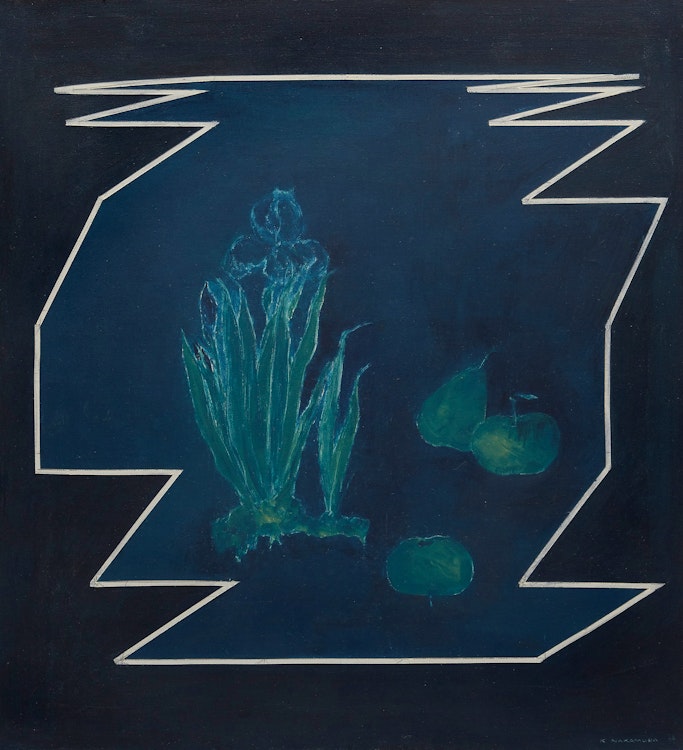Suspension 5 by Kazuo Nakamura

Kazuo Nakamura
Suspension 5
oil on canvas
signed and dated 1968 lower right; signed and dated 1968 on the stretcher; titled on a label on the reverse
24 x 22 ins ( 61 x 55.9 cms )
Auction Estimate: $9,000.00 - $12,000.00
Price Realized $8,496.00
Sale date: September 24th 2020
Private Collection, Toronto
Iris Nowell, “Painters Eleven: The Wild Ones of Canadian Art”, Vancouver/ Toronto, 2010, page 301 and 305
Working with themes over an extended period of time, Nakamura was very process-based in his work. Favouring the distillation of restrained, meditative calm, Nakamura looked to the principles of mathematics and geometry to balance his artworks with exacting precision. Pursuing “a further purity of expression”, the artist revisits the still life genre again with his use of fruits and florals, encircled by a jagged white border contrasting the inky indigo background in “Suspension 5”. The still-life objects explore the elegance and tranquility of simple organic beauty, blending with the background and hanging suspended in the pictorial space.
Gentle tonal variation is a hallmark of Nakamura’s late 1960s works in which the artist employs subtle tonal shifts to embrace a restrained calm. Encouraging prolonged engagement and reflection, “Suspension 5” is an excellent example of the artist’s marriage of figurative and abstract painting in the canon of post-war Canadian art.
Share this item with your friends
Kazuo Nakamura
(1926 - 2002) Painters Eleven
Born in 1929, Kazuo Nakamura was a founding member of Painters Eleven, an Ontario based group of abstract artists inspired by other Canadian landscape painters and were active between 1953-1960. Nakamura distinguished himself from the other painters in the group due to his simplistic abstractions and precision. Nakamura was born in Vancouver, British Columbia, and during World War II he was imprisoned in Tashme, a Japanese internment camp. After the war, Nakamura moved to Toronto and attended the Central Technical School from 1948-51.
Using a constrained pallet and drawing inspiration from Hungarian-born photographer László Moholy-Nagy as well as fellow Painters Eleven group members like Jock Macdonald, Nakamura explored science, time, and spatial perspectives through his abstracted paintings. Through his experimental techniques he explored the perception of beauty and the social positioning of artists in society. He believed that there was a universal pattern in life that created beauty in everything, including Tashme where he was imprisoned.
Nakamura’s style can be described in four major stages, which are known as Inner Structures, Block Structures, Topology, and Number Structures. These stages were elaborated on at the 2004 posthumous retrospective “Kazuo Nakamura: A Human Measure” exhibited by the Art Gallery of Ontario. Each stage was informed by his fascination for science and influenced by the work of mathematicians and philosophers, such as Blaise Pascal. Nakamura’s earliest stage, Inner Structures, features black lines on colored backgrounds and explores the relationship to natural and built forms. Second, Block Structures channel contemporary architectural elements as well as Italian artist Giorgio de Chirico. Block Structures appear as three-dimensional geometric forms on empty planes. Inner and Block structures began after he finished his studies at the Central Technical School in the early 1950s. In Nakamura’s third stage, Topology, he was primarily focused on creating mappings using lines, curves, and grids. Finally, through Number Structures, Nakamura incorporated ideas put forth by Pascal to explore fundamental number patterns through grid-like structures. Nakamura focused on Topology and Number Structures in the 1970s and 1980s as exploration of the chaotic nature of the world in which he lived.
In 2000, Nakamura was made an honorary fellow at the Ontario College of Art and Design, he was also a member of the Canadian Academy of Arts. He passed away in 2002 in Toronto.
Literature Sources:
Carpenter, Ken, “Kazuo Nakamura,” The Canadian Encyclopedia, Historica Canada, Accessed June 15, 2020
Koch, Phil, “Kazuo Nakamura: A Human Measure, Art Gallery of Ontario, Toronto,” Border Crossings, February 2005
We extend our thanks to Danie Klein, York University graduate student in art history, for writing and contributing this artist biography.

